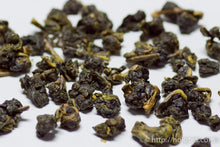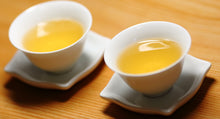The words "Deep Fermented Dong Ding" sounds sophisticated and something new, and you might feel it is difficult to imagine the taste and flavour of this tea. Nevertheless, Deep Fermented Dong Ding is the traditional style of Taiwanese Oolong Tea. Traditionally in the past, the fermentation of Taiwanese oolong tea undergone longer period of time, and the extent of fermentation is deeper than modern Taiwanese oolong. Tea gives a multi-layer of fruity note that lingers down the throat for a long time. The flavor of this tea is like peaches or chestnut. It is the tea boomed in Taiwan back in 1980's.
Dong Ding Oolong is one of the very popular teas in our line-ups. Our standard Dong Ding Oolong is produced following modern style, and it is different from Deep Fermented Dong Ding Oolong. This is a very rare Taiwanese Oolong tea, because of it requires a more intensive labor work and time-consuming, so, nowadays the lightly-fermented oolong becomes the main stream of Taiwanese oolong. Nevertheless, the maker of this tea still follow the tradition inherited from their ancestors, so still they produce this tea every year for their own consumption, it is not a mass-production products available as a common lineups. Thanks to our long-term working relationship with the tea maker, we manage to get a little quantity out from the stock they made for their own. Due to the deeper fermentation, tea ages very well, and it gives a sweet fruity note like peaches or mangoes.
Nowadays, Dong Ding oolong is produced with lighter fermentation and therefore, tea remained green and it gives flowery and refreshing flavor. In fact, the same processing technique is applied for almost all type of oolong teas in Taiwan. Tea from different mountains such as Ali Shan, Li Shan and Da Yu Lin undergoes very similar process. Under the circumstances, it is hard to recognize the identity of respective oolong tea. It also creates the trend that customer keeps chasing after the tea produced from higher altitude. As Dong Ding Mountain is not a high mountain, people tend to associate Dong Ding oolong as an entry tea of Taiwan oolong. Customer who has already tried the oolong tea produced from very high mountain tends to lose their interest in tea from lower altitude. They often think there is nothing more to look for.
We wish to introduce tea that is made with different processing technique. With this practice, tea gives different characteristic in addition to the quality reflected from respective mountain.

Firstly, we would like to introduce the Deep Fermented Dong Ding oolong. It is also called Dong Ding Oolong Traditional style. This tea is made with exactly the same processing method as traditional Dong Ding oolong back in 1980s. In Taiwan, Dong Ding oolong was a very big fad about 30 years ago. At that time, tea was deeply fermented and it gave very fruity flavor, like ripen fruit. It gives full body with lingering sweetness that stays for a long time on our throat. Once we have tasted this tea, we will not forget about its taste. Usually, the more we drink tea, the higher the fermentation we tend to look for. In a way, Deep Fermented Dong Ding oolong gives a higher level of satisfaction in drinking.
I was in Taiwan for the quest of Deep Fermented oolong tea. Deep fermentation does not mean the fermentation step is simply prolonged for a longer period of time. The fermentation of oolong tea is referring to the withering process. During withering, tea leaves are tossed using a bamboo plate in order to bruise the edge of tea leaves. This causes the tea juices to be exposed to the air which initiate the process of fermentation. Bruised leaves will be then be spread over the bamboo plate and let it set for a while. After a certain period of time, this series of tossing-setting step is repeated. This process required very high skill and a lot of care in handling. Considering the fact that the process of ordinary lightly fermented oolong takes about 24 hours, it is definitely tougher to produce deeply fermented tea. It is a very labor-intensive work to conduct deep fermentation.
In fact, the commercial market is unwilling to pay a higher price for the deep fermented oolong, thus, tea manufacturer is not very keen to produce deep fermented tea but to switch to less fermented oolong tea which is more cost-effective and required less energy in handling.
Another obstacle is that not every tea manufacturer masters the skill to produce deep fermented oolong. The young tea maker has had very little experience in making this tea, while elderly tea masters have the know-how yet they are reluctant to produce. With such constraints, we still managed to purchase tea from the tea master who believes that he has to preserve the tradition of Dong Ding Oolong.
This tea is processed without charcoal-firing process, unlike to Deep Fired Dong Ding oolong. The tea appears in golden color. It gives a rich flavour like matured fruit with a note of sweet chestnut flavour. You may also notice a scent of cinnamon. It is an intensely aromatic and full-bodied tea.
Deep Fermented Dong Ding oolong gives a thicker color compared to the normal Dong Ding oolong.
Process
Basically, all light fermented oolong undergoes similar process.
Brewing Method
(1) Water
In you are using tap water, it is necessary to filter the water using an activated carbon filter. If not, you wouldn’t be able to enjoy the authentic taste of tea. Chlorine is added to tap water in order to sanitize bacteria. This chlorinated water will also harm our body cells. Concerning about our health condition, it is very important to remove chlorine from drinking water. The most effective method in removing chlorine is to install an activated carbon filter. This type of filter is designed for removing organic substance. It will remove not only chlorine, but also other harmful substance such as contaminated pesticide. The activated carbon filter can be easily obtained from the common hardware shop in most countries. If activated carbon filter is not available, please place a charcoal inside the water and leave it for over night. The material composed of activated carbon filter is made of ground charcoal. The difference is that activated carbon filter contains much finer particles and hence it has extremely large surface area for a better efficiency in filtration. We do not suggest RO water (reversed osmosis water) or distilled water. This water carries no mineral, the taste and flavor of tea tends to be very unstable, unless you have very superior quality tea and tea equipment.It is also advisable not to use fresh tap water. The intensity of after taste becomes stronger if water is kept overnight. Keeping water with stones or inside clay jar will increase the content of minerals. However, you need to confirm whether or not the water kept inside particular jar or with stone is suitable with your tea or tea equipment (such as teapot). If water jar carries certain minerals like copper or zinc, it will rather spoil the taste and flavor of tea. For this, you need to confirm with experiment on try and error basis.
For boiling water, please do not use aluminum or copper kettle. It spoils the taste of water. We suggest using kettle made of iron, stainless steel, tin or glass.
In the long run, you may observe a thick layer of scale accumulated inside your kettle. Our mother usually taught us to wash and remove it with citric acid. But please do not even try to remove the scale. Scale consists of minerals that exist in the water. The mineral composition is reflected from the water you used. If you remove the scale, the mineral ion balance between scale and water is destroyed. This balance is called buffer effect in science. The flavor and taste will seriously run out and you won’t be able to get previous taste and flavor for a long time. It is also important to stick to the same type of water whenever brewing tea. If source of water is changed, it carries different type of minerals. It will affect the mineral ion balance too.
(2) Quantity of tea leaves
To determine the quantity of tea leaves to be used, we divide the volume of water by 50. For example: the volume of teapot = 200ml; 200ml/50 =4g. You need to measure 4g of tea leaves for 200ml of water.
(3) Temperature
It is important to use boiling water. Please do not stop as soon as water is boiled. It is advisable to keep boiling for about 30 seconds to 1 minute.
(4) Brewing time
Based on the above ratio between hot water and the weight of tea leaf, the brewing time is as follow.
1st: 55 seconds
2nd 45 seconds
3rd 55 seconds
4th 65 seconds
5th 75 seconds
6th 85 seconds
Note: Please remove the lid while you are waiting for subsequent brewing. Tea leaf will be over steamed and get oxidized if the lid is not removed.
In order to enjoy oolong tea, always ensure that the water temperature is very hot. Use boiling water and rinse tea pot with boiling water to keep it hot.
Storage of Tea
Keep tea away from moisture
Once a bag of tea is opened, please finish it within 3 months if you wish to enjoy its freshness. From the medical point of view, it is safe to consume the tea even if it is kept for a few years. However the freshness disappears if it is kept for too long. Tea must be tightly sealed before it is kept. Tea should be kept in ambient and dry conditions such as in the living room, but it must be completely away from humidity. Tea should not be kept in the kitchen as the environment is very humid. Avoid enclosed area such as inside the cupboard or drawer as these places are damp. Also avoid opening the bag of tea in humid atmosphere. It is recommended to open the bag during a sunny day or under air-conditioned atmosphere. Once tea leaves absorb moisture, deterioration of tea will be triggered within a few days. Tea will then give an astringent taste, sometime it tastes sour. The fresh aroma also becomes weaker.
Beware of keeping the tea in the fridge
The quality of tea lasts longer if it is kept in the fridge. However we strongly recommend you not to keep tea in the fridge. When tea is withdrawn from the fridge, there is usually condensation. Once tea is exposed to moisture during condensation, the quality will deteriorate within a few days. The higher moisture content in the tea leaves will trigger oxidation and it will completely destroy the quality of tea.
Here’s one frequently asked question: what happens if bag is sealed using tape or tea is packed in zipper bag and kept inside the fridge?
For your information, these simple sealing methods are not sufficient. When the bag is withdrawn from the fridge, it is cold inside the bag and therefore causes negative pressure. Air will be drawn from outside and condensation will occur. In addition, if the bag is taken in and out from the fridge very often, this will cause heat stress to the tea leaves as temperature is increased and decreased very frequently. If tea is kept in the fridge, when it is withdrawn from the fridge, it is necessary to leave it in ambient atmosphere for more than 24 hours in order to warm up the tea leaves. Based on our experience, 12 hours is not long enough. We may think tea is warmed up, but inside the bag, the tea leaves are still cold due to insulation effect.








